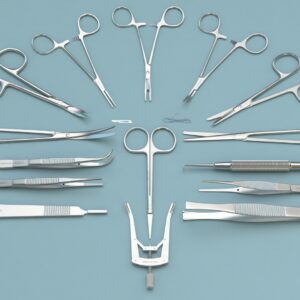$4,600.00
The Intelligent Anesthesia Ventilator is a device specifically designed for precise and efficient ventilation of animals during anesthesia. It incorporates advanced technology and intelligent control algorithms to deliver optimal respiratory support. With its user-friendly interface and comprehensive monitoring capabilities, researchers can easily adjust ventilation parameters and ensure the well-being of the animals. This ventilator is an essential tool for respiratory studies and anesthesia research in the field of life sciences.
ConductScience offers the Intelligent Anesthesia Ventilator.

RWD is a global leader in the design and manufacturing of advanced research and laboratory equipment. Specializing in high-precision instruments for neuroscience, behavioral science, and pharmacology.

bool(false)


Product Name | Model/Specification |
|---|---|
Application | Patient weight <=100kg |
Gas supply pressure | 41-87Psi |
Respiration rate | 2-60bmp(adjustable) |
Tidal volume output | 20-1500ml(adjustable) |
I:E | 1:1.1-1:4.0(adjustable) |
Peak inspiratory pressure | 5-35cmH2O |
Trigger pressure | -9.0〜-1.0cmH2O |
Touch color screen | 5 inch, 800 × 480 |
Dimension | 253mm×224mm×112mm |
Weight | 3.22kg |
Power supply | 110v-220v |
Mechanical ventilation plays a crucial role in the survivability of patients and animals with poor respiratory functions. Ventilation in these situations can be either support or completely replace spontaneous breathing. Inadequate gas exchange indicates the need for mechanical ventilation. This can be indicated by severe hypoxemia despite oxygen therapy (PaO2 <60 mm Hg), severe hypoventilation (defined as PCO2 >60 mm Hg), excessive work of breathing, or severe circulatory shock. Hypoxemia can result from inadequate inspired oxygen, the elevation of the partial pressure of carbon dioxide (PCO2) (hypoventilation), or venous admixture.
Mechanical ventilation also is a common component of anesthesia practices due to the respiratory system depression caused by most anesthetic agents. Further, to make the handling of animals easier, neuromuscular blocking (NBM) agents are often used during anesthesia and surgical procedures. These agents induce paralysis and hence require the use of mechanical ventilators to ensure adequate respiratory functions. Though specific animal mechanical ventilators are available, mechanical ventilators no longer used for humans can also be repurposed for use in animal-based studies. Mechanical ventilators are selected based on the size and weight of the animal.
The most common design of large animal ventilators is the bag-in-the-box design system. These systems rely on compressed gas to power a bag or bellow to empty and push a volume of gas into the lungs in a large animal circle system. They provide an isolated interface between the breathing system gases and the gases that power intermittent positive pressure ventilation (IPPV). The bag-in-the-box systems, however, do not offer positive end-expiratory pressure (PEEP) or are limited to a value of 10 cmH2O. Further, they tend to be rather noisy due to their significant dependence on compressed gas to operate. The latest large animal ventilators make use of electrical motors and arrangements for the movement of the gas in the system to overcome the shortcomings of the bag-in-the-box systems. Compared to their older counterparts, the latest mechanical ventilators’ microprocessor capabilities offer a direct and wide range of control of the ventilation parameters. Apart from the achievability of desired patterns, the latest systems also allow a variety of ventilation modes including a wide range of PEEP and do not require disconnection or switching of breathing bags during spontaneous breathing.
Conduct Science offers a mechanical ventilator for large animals weighing up to 100 kgs. The ventilator can be used for large mammals including rabbits, dogs, monkeys, pigs, sheep. (For small animal ventilators click here and here)
The 5.8 kg device has a dimension of 22.5 x 2.8 x 3.2 cm. The ventilator comes with two interchangeable bellows of capacity 0 to 300 ml and 300 to 1500 ml. The mechanical ventilator is also equipped with dual LED and sound alarm modifiable trigger settings for monitoring proximal airway pressure in real-time. It also has provisions for multiple gas supplies; O2, nitrogen, and clean, dry air. Apart from these features, the mechanical ventilator has the following technical specifications and features,
Mode Of Operation
As opposed to manual ventilation, mechanical ventilators allow the precise control of the duration of inspiration and expiration, the volume of gas delivered to the lungs, and the pressure reached in the airway during inspiration. Ventilators achieve controlled ventilation by application of intermittent positive pressure to the airway, which can be accomplished by directly delivering gas to the anesthetic breathing system or indirectly by compressing a rebreathing bag or bellows.
The first step of ventilating an animal involves the calculation of the required tidal volume (approximately 7 to 10 ml/kg body weight) and selection of the respiratory rate. Generally, the rate is selected slightly lower than the normal resting rate of the animal when it’s conscious. In case the ventilator does not have direct settings for tidal volume and respiratory rate then they are most likely to have settings for inspiratory time and inspiratory flow rate.
Further, some ventilators may only provide controls for inspiratory time and inspiratory: expiratory (I: E) ratio. The ratio is usually set to 1:2, however, a ratio of 1:3 and 1:4 can also be used without causing significant cardiac depression while maintaining inflation pressures below 20 cm water. Apart from these variables, maximum inspiratory pressure should also be set on the ventilator at less than 15 cm water for small animals and not more than 25 cm water for large animals, under most circumstances.
Mechanical ventilation in animals is often used in researches that require long-term use of anesthesia or when neuromuscular blocking agents are used during surgeries. Controlling ventilation relies on the use of an endotracheal tube or the placement of a tracheal cannula if the animal is not intended to recover. These methods prove successful in comparison to using a face mask, which risks the inflation of the stomach, and laryngeal masks. Once the tube or cannula is placed, it is then connected to the ventilator to allow mechanical ventilation.
Prior to beginning the procedures of mechanical ventilation, it should be ensured that all the equipment and instruments used are thoroughly cleaned. The subject must be adequately and appropriately anesthetized before and during the entirety of the procedure to ensure humane treatment.
Endotracheal Intubation
Endotracheal intubation is assisted by a laryngoscope. The type of endotracheal tube and laryngoscope (Miller laryngoscope and Macintosh laryngoscope) used are dependent on the size and weight of the subject. An appropriate length for an endotracheal tube is usually the approximate distance from the external nares to just anterior to the thoracic inlet. The tubes should be lubricated with a small quantity of lidocaine gel to allow easy passage. Further, cough and swallowing reflexes should be adequately numbed. It is recommended that the animal is administered with oxygen for about 2 minutes before being intubated to slow the advent of hypoxia should the larynx be obstructed. The detailed methodology of endotracheal intubation of different animals can be found here.
The procedure of insertion of the endotracheal tube is performed by resting the animal on its back (generally), with the neck and head flexed. The laryngoscope is then advanced over the tongue towards the pharynx. Care must be taken to extend the tongue and avoid damaging the surface of the teeth of the animal. Following successful laryngoscopy, the endotracheal tube is advanced into the trachea.
Performing Laryngoscopy Using MacIntosh Blades
Tracheostomy
Evaluation of effects of mechanical ventilation on coagulation and fibrinolysis in ARDS model
Wang and Shen (2015) evaluated the effects of ventilation using different tidal volumes on coagulation and fibrinolysis in rabbits with acute respiratory distress syndrome (ARDS). ARDS was induced using a sequential injection of 0.1 mL/kg oleic acid (OA) and 500 μg/kg lipopolysaccharide (LPS) via an auricular vein. Healthy adult male rabbits were divided into 5 groups of which one group served as a sham and another as a model group. Animals in the other groups were either ventilated on low VT (6 mL/kg), routine VT (10 mL/kg), or high VT (15 mL/kg). The experiment was concluded after 6 hours of LPS injection. Data collected based on the blood samples showed that mechanical ventilation with low VT improved coagulability and fibrinolytic status, while ventilation with routine VT had little effect on coagulability and fibrinolytic status. However high VT ventilation significantly deteriorated the coagulability and fibrinolytic function in ARDS.
Investigation of the effect of airway humidification during mechanical ventilation
Jiang et al. experiment aimed to establish a relationship between airway humidification and mechanical ventilation-induced lung inflammatory responses. For their investigation male Japanese white rabbits were divided into control animals, dry gas group (no humidification), and experimental animals. The control animals were sacrificed soon after anesthesia while the dry gas and experimental group were on mechanical ventilation for 8 hours. The experimental group was further divided into groups that underwent ventilation with humidification at 30, 35, 40, and 45°C. Results of the investigation showed that the dry gas group showed increased tumor necrosis alpha factor levels in bronchoalveolar lavage fluid (BALF) compared to the controls. At a humidification temperature of 40°C, it was observed that tumor necrosis factor-alpha and interleukin-8 levels in the BALF reached baseline levels. Further, at 40°C humidification pathological injury was reduced in comparison to other groups based on the histological score. It was concluded that appropriate humidification reduced inflammatory responses, reduced damage to cilia, and reduced water loss in the airway.
Assessment of the process of de-recruitment in normal lungs ventilated for 16 hours
Tucci et al. evaluated lung dysfunction and inflammation in anesthetized sheep ventilated at 8 mL/kg VT and PEEP at zero. Based on the emission scans taken at baseline and after 16 hours, it was observed that the gas fraction decreased in dorsal (0.31±0.13 to 0.14±0.12, P<0.01), but not in ventral regions (0.61±0.03 to 0.63±0.07, P=nonsignificant), with time constants of 1.5 – 44.6 hours. Further, shunt increased in dorsal regions (0.34±0.23 to 0.63±0.35, P<0.01), though no change in the vertical distribution of relative perfusion was observed. After 16 hours, an increase in the average pulmonary net F-fluorodeoxyglucose uptake rate (3.4±1.4 to 4.1±1.5 10(-3)/min) was observed in the regions of interest along the ventral-dorsal direction. Also, in the corresponding average regions of interest, the F-fluorodeoxyglucose phosphorylation rate increased from 2.0±0.2 to 2.5±0.2 10(-2)/min (P<0.01).
Assessment of effects of mechanical ventilation on abdominal edema and inflammation in sepsis
Lattuada et al. speculated that mechanical ventilation led to an increase in abdominal edema and inflammation in sepsis. This speculation was tested in the porcine endotoxemia model. Anesthetized pigs were divided into healthy controls and endotoxemia groups. Healthy control pigs either breathed spontaneously with continuous positive airway pressure (CPAP) of 5 cm H2O or were mechanically ventilated with PEEP of 5 cm H2O for 5 hours. The endotoxin group received intravenous endotoxin at a dose of 15 μg/kg/h for 2.5 hours during mechanical ventilation (MV) with PEEP of 5 cm H2O (MV + PEEP5). Following this, they were divided into groups that were maintained on MV + PEEP5, MV with PEEP of 15 cm H2O, or spontaneous breathing (SB) with CPAP of 5 cm H2O for another 2.5 hours. Isotope technique was used to estimate abdominal edema formation and inflammatory markers were measured in liver, intestine, lung, and plasma. The data obtained from the investigation suggested that mechanical ventilation with positive end-expiratory pressure increased abdominal edema and inflammation in the intestine and liver by increasing systemic capillary leakage and impeding abdominal lymph drainage.
Animals should be handled appropriately, and humane treatment must be ensured throughout the procedures to avoid undue injury or stress to the animal. All equipment and apparatus must be thoroughly cleaned before use to avoid chances of infections and other complications. Animals should be anesthetized appropriately, and measures to maintain the appropriate depth of anesthesia should be followed. It is important to monitor the anesthesia and vital signs of the animal throughout the procedure. Further, the tubes leading to the animal containing inspired air and the tubes returning from the animal containing expired air should be kept as short as possible to minimize dead space. If the animal is expected to recover from the procedure, an appropriate recovery area should be maintained, and a recovery routine should be followed.
Modern mechanical ventilators, unlike their older versions, rely on electricity to operate. In addition to power backups and other modes of power, modern ventilators also allow the option of manual ventilation. Further, as opposed to the older versions, modern ventilators allow more control over ventilation parameters. In clinical practices, a single device for mechanical ventilation makes the technical features of the ventilation procedure simple. The device mitigates the need for a separate piece of equipment and the hassle of shifting the subject during the experiment as seen with manual devices. The programmability of mechanical ventilators also helps guarantee the standardization of protocol and repetition of the procedure between subjects; This capability helps reduce ambiguity in research and promotes the accuracy of results. The diversity in sizes of the mechanical ventilators permits researchers to research animals of different weights and sizes without any restrictions.
Classical large animal ventilators do not generally offer positive end-expiratory pressure or have PEEP restricted at 10cmH2O. Further, these systems are dependent on a substantial amount of compressed gas in addition to being noisy. As with any equipment, the mechanical ventilator must be monitored to avoid any issues that can arise during assisted ventilation. It is important that breathing motion and lung volume are monitored throughout the various stages of the breathing cycle. Prolonged ventilation may affect the survivability of the subject. Additionally, extrapolating the research results to other animals of different ages or species has its limitations.
| Weight | 18.96 lbs |
|---|---|
| Dimensions | 52 × 36 × 37 cm |
| Power Supply | 100-220V, 100-240V |
You must be logged in to post a review.
There are no questions yet. Be the first to ask a question about this product.
Reviews
There are no reviews yet.